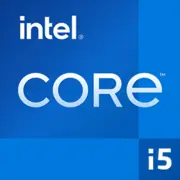Intel Core i5-11500T

Intel Core i5-11500T: A Comprehensive Review of the 2021 CPU in 2025
Introduction
The Intel Core i5-11500T processor, released in 2021, remains a popular choice for budget and energy-efficient PCs even in 2025. Despite the arrival of new generations, it attracts attention due to its low TDP (35W), support for modern interfaces, and stable performance. Let's explore who this CPU is suitable for today and what nuances to consider when building a system with it.
Key Specifications: Rocket Lake on 14 nm
Architecture and Process Technology
The i5-11500T is based on the Rocket Lake architecture, the last for Intel's 14nm process. It features a 6-core processor with 12 threads thanks to Hyper-Threading. The base frequency is 1.5 GHz, with a maximum turbo boost of 3.9 GHz. Despite its “age,” it shows commendable efficiency in office and multimedia tasks.
Cache and Graphics
The L3 cache size is 12 MB, providing quick access to frequently used data. The integrated graphics UHD Graphics 750 (32 EUs, 1300 MHz) are suitable for basic gaming (e.g., CS:GO at low settings) and working with 4K video.
Performance
- Geekbench 6: 1653 (Single-Core), 5098 (Multi-Core). For comparison, the Ryzen 5 5600G scores around 1600/5700, making the i5-11500T a competitor in multi-threaded tasks.
- TDP 35W: Ideal for compact PCs and systems with passive cooling.
Key Features
- Support for PCIe 4.0 (20 lanes) for fast NVMe drives.
- Intel Quick Sync Video technology (video encoding acceleration) and AES-NI (data encryption).
Compatible Motherboards: LGA 1200 Socket
Chipsets and Socket
The processor uses an LGA 1200 socket. Suitable chipsets include:
- H510: A budget option for office PCs (from $60). No RAM overclocking.
- B560: The optimal choice (from $90). Supports DDR4-3200 and has an unlocked multiplier for memory.
- Z590: Premium segment (from $150). Allows CPU overclocking (although the i5-11500T is locked).
Example Boards
- ASUS Prime B560M-A: A reliable board with two M.2 slots (price ~$110).
- Gigabyte Z590 UD AC: Supports Wi-Fi 6 and PCIe 4.0 x16 (~$140).
Selection Tips
- The B560 is sufficient for the i5-11500T: the Z590 is redundant due to the lack of overclocking.
- Check for PCIe 4.0 support: not all H510 boards activate this feature.
Supported Memory: DDR4-3200
The i5-11500T works with DDR4-3200 (officially) in dual-channel mode.
- Recommendations:
- 16GB (2×8 GB) DDR4-3200 CL16 is optimal for gaming and multitasking (cost ~$50).
- Avoid modules higher than 3200 MHz: the processor does not support them.
- Important: The motherboard must support XMP profiles for automatic memory overclocking.
Why not DDR5?
The Rocket Lake architecture is not adapted for DDR5, which limits upgrades. However, in 2025, DDR4 is still relevant for budget builds.
Power Supplies: Power Calculation
With a TDP of 35W, the i5-11500T consumes up to 70W under load. However, the overall system power depends on the components:
- Integrated Graphics: Minimum PSU — 300W (e.g., be quiet! Pure Power 11 300W, ~$45).
- Discrete Graphics Card (e.g., GTX 1650): A 450-550W unit (Corsair CX550M, ~$70).
Tips:
- Choose a PSU with an 80 Plus Bronze/Gold certification for stability.
- For fanless builds, use units with passive cooling (e.g., Seasonic Prime Fanless TX-600, ~$200).
Pros and Cons
Pros:
1. Energy efficiency: Consumes less power than standard i5 models.
2. UHD 750: Better than Vega 8 in the Ryzen 5 5600G for video work.
3. PCIe 4.0: Fast SSDs (e.g., Samsung 980 Pro) operate at full speed.
Cons:
1. 14nm process: Higher heat output compared to 7nm AMD.
2. No DDR5 support: Limitations for future upgrades.
3. Locked multiplier: Overclocking is not possible.
Use Cases
1. Office and Multimedia
- Streaming 4K video, working with office applications. Example: a system based on the i5-11500T with 16GB RAM and an NVMe SSD handles 20+ tabs in Chrome.
2. Light Gaming
- The UHD 750 runs Dota 2 at 1080p/30 FPS or GTA V on low settings. For comfortable gaming, add a graphics card like the RTX 3050.
3. Home Server/NAS
- Low power consumption and virtualization support (VT-x) make it ideal for Proxmox or TrueNAS.
Comparison with Competitors
1. AMD Ryzen 5 5600G (6/12, Vega 7, TDP 65W, ~$130):
- Pros: Better multi-threaded performance (+10% in Cinebench R23).
- Cons: Higher power consumption, no PCIe 4.0.
2. Intel Core i5-12400T (Alder Lake, 6/12, UHD 730, ~$180):
- Pros: More modern architecture, DDR5 support.
- Cons: Higher price, requires an LGA 1700 motherboard.
Conclusion: The i5-11500T excels in budget builds focused on energy efficiency.
Practical Assembly Tips
1. Motherboard: ASRock B560M Pro4 — optimal balance of price and functionality (~$100).
2. Cooling: The standard stock cooler is adequate, but for quiet operation, consider the DeepCool GAMMAXX 400 V2 (~$20).
3. Storage: 1TB NVMe SSD (WD Blue SN580, ~$60) + HDD for backups.
4. Case: Compact Mini-ITX (Fractal Design Node 304, ~$90) for a media center.
Final Conclusion: Who Should Choose the i5-11500T?
You should consider this processor if you:
- Are building an energy-efficient PC for office work or a home theater.
- Want to save by using DDR4 and motherboards from 2021-2023.
- Plan to upgrade in 2-3 years: a system based on the i5-11500T will cost around $300 (without a graphics card), cheaper than new platforms.
In 2025, the i5-11500T is a wise choice for those not requiring the "latest technology" but prioritizing reliability and low energy consumption.
Basic
CPU Specifications
Memory Specifications
GPU Specifications
Benchmarks
Compared to Other CPU
Share in social media
Or Link To Us
<a href="https://cputronic.com/en/cpu/intel-core-i5-11500t" target="_blank">Intel Core i5-11500T</a>